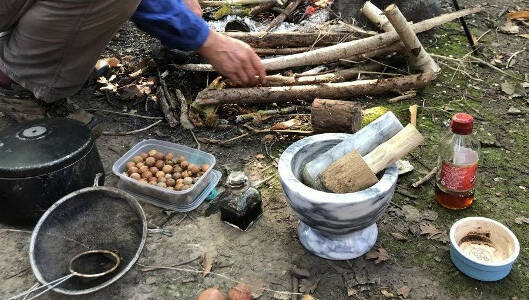Making oak gall ink
A campfire craft activity making ink from earth (oak galls), air, wind and fire - who'd have thought?!

Introduction
Making ink is an artform and an experimental process - many people have ‘played’ with this process for centuries. Inspired by ‘organic artist’ Nabil Ali at the National Forest School conference in Essex in 2015, I have been experimenting with this process for the last 4 years and am still perfecting it. It is a revealing mystical process – an alchemy of the 4 elements, so do play with it – it is not precise. Each time the ink comes out slightly differently and I guarantee a WOW each time. I have worked with this from early years up to adults.
What you'll need
- fire for cooking
- 1 tbsp vinegar
- 1/2 tsp gum Arabic (available from any arts supplier – it is expensive but you are only using a small amount each time), or resin from pine tree
- at least 10 rusty nails (more the merrier!)
- ¼ – ½ pint water
- good handful of oak galls. You can either use oak apple or knopper galls – I have found the oak apples, to be found mostly on younger oak trees, give a darker ink. Acorns can be used but don’t have the tannin content of galls so you get a much fainter ink
Jon Cree

Useful items from our shop
Environmental Considerations
Consider the environmental impact of preparing, carrying out & completing this activity. Could this impact be reduced? Specific considerations for this activity could include:
- leave no trace
- galls – collect the brown ones on twigs - with the hole.
Health & Safety Considerations
Follow your usual operating procedures and carry out appropriate risk benefit assessments.
Some considerations particular to this activity include:
- fire safety
- use of knives.
To get the most out of the process give gratitude to natures’ ability to transform itself into something that has created history, indeed, dare I say it… civilisation… the written word! Each step needs to be honoured – from the relationship between the oak tree and gall wasp that produces the oak gall – the earth element of the process – through to the water, air (in the form of rusty metal – earth again!), and the wood that provides the fire which transforms the air water and earth into INK!
While doing this, contemplate that the first long book of English history, written by St Bede, was written by the very same ink or, if you are into Christian history and art, the Book of Kells, the four gospels of the new testament written and drawn in the 8th century and housed in Dublin.
Jon Cree
A note on oak galls:
There are about 30 species of oak gall wasps, all with different life cycles! The ones that make the best ink are the oak apple and the knopper gall wasp. Oak apple galls are ideal.
The wasp (Biorhiza pallida) lays their eggs inside leaf buds, causing flattened rounded galls that develop on twigs in spring. The galls have a spongy texture and are brownish white, tinged with pink. Males and female wasps emerge in mid summer then the gall turns woody and brown, and they go on to lay eggs on oak roots. The next (asexual) generation produces marble-like galls on the roots, from which females emerge in late winter to lay eggs in buds on the twigs.
NB Be sure to only collect the brown galls on twigs, with the hole in them – this means the wasp has left!
What an amazing relationship between tree and insect and then US!
For more on galls generally, and oak apple galls in particular, read this description from the Woodland Trust.

Method:
- Crush the galls (EARTH) in the pestle & mortar
- Add (WATER)
- Put in a pan on the (FIRE)
- Add rusty nails and vinegar which help the oxidation process (AIR) – then boil
- Remove from heat and sieve the ink into a container
- Mix in gum Arabic (more EARTH) – this helps fix the ink to paper.
Make your own pen:

Take a feather for the quill and shape the end by making a quick diagonal cut – you should have something akin to an ink pen end.
On larger feathers you can make a small split at the end, then poke a paper clip up the end to push the pith up into the pen so it can hold the ink.
Now write….

Go ahead and write your own musings on the oak tree or your connection with the natural world.
Take it further:
Find out more about the chemistry involved in iron gall ink.
A good resource for organic ink and paint making is Nick Neddo’s book The Organic Artist, published by Quarry Books, 2015.
Disclaimer: Muddy Faces cannot take any responsibility for accidents or damage that occurs as a result of following this activity.You are responsible for making sure the activity is conducted safely.
Key Features
- Age Range 3+
- Duration 1 - 2 Hours
- Location Anywhere
- Season Autumn
- Time of Day Anytime
-
Categories:
Art & Creating
campfire craft
inks, dyes & perfume
Tool use & Traditional Crafts
fire craft
Fire, Shelters & Bushcraft
fire



